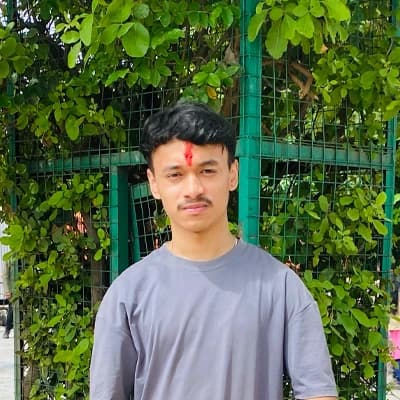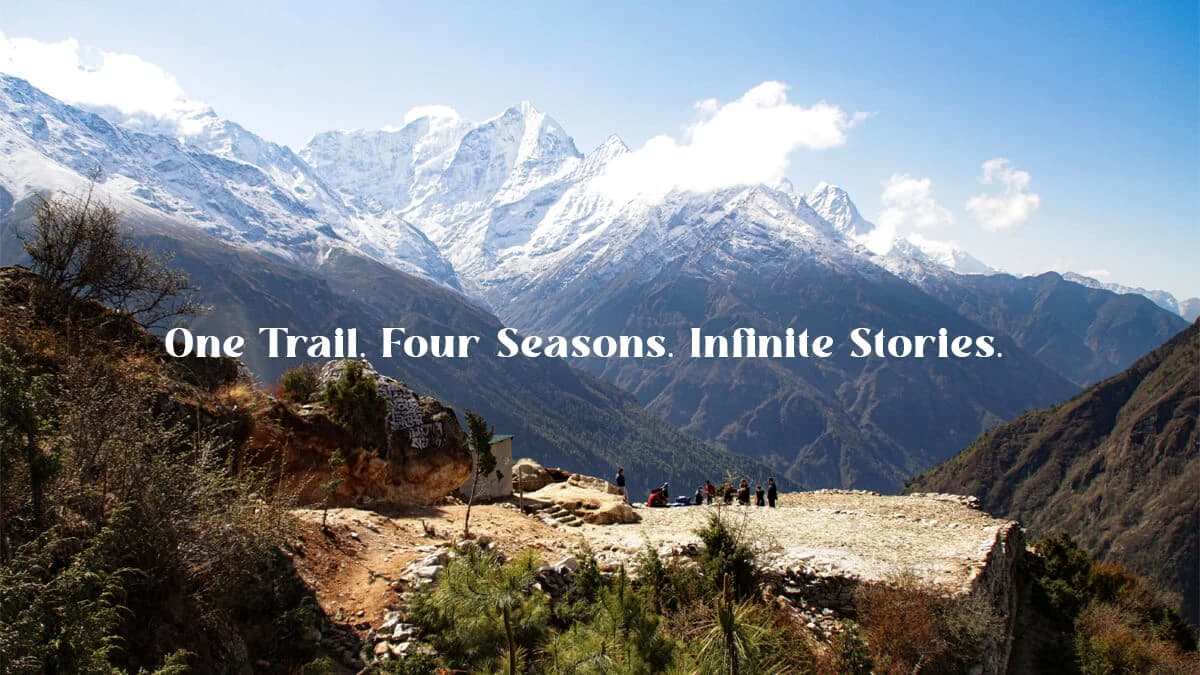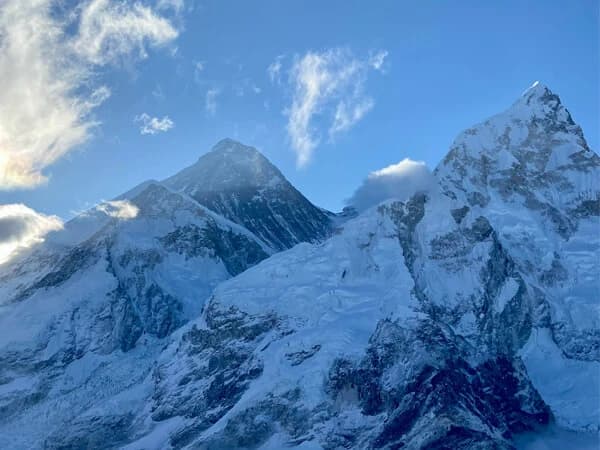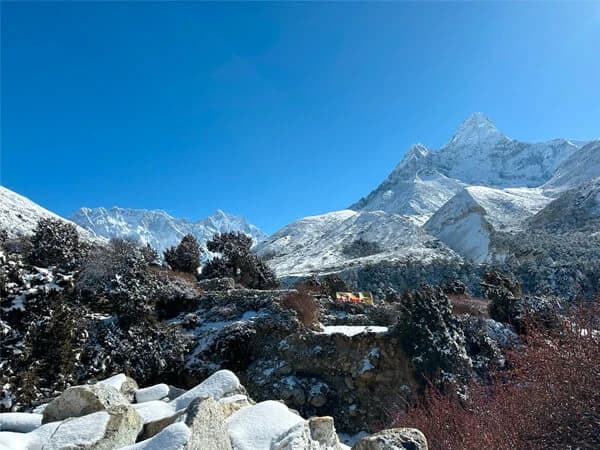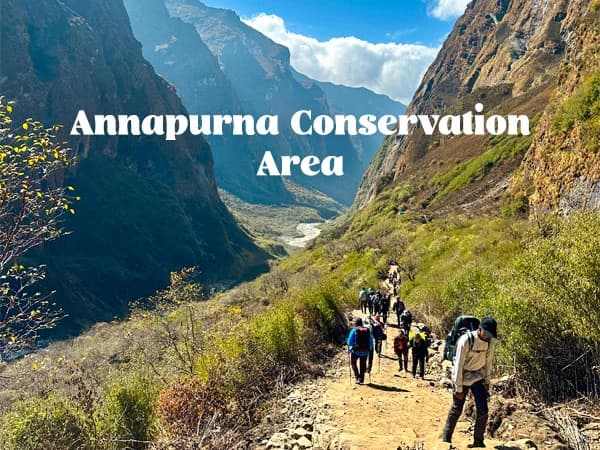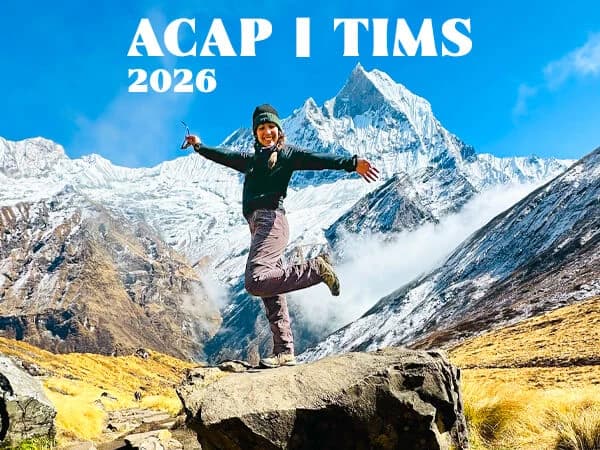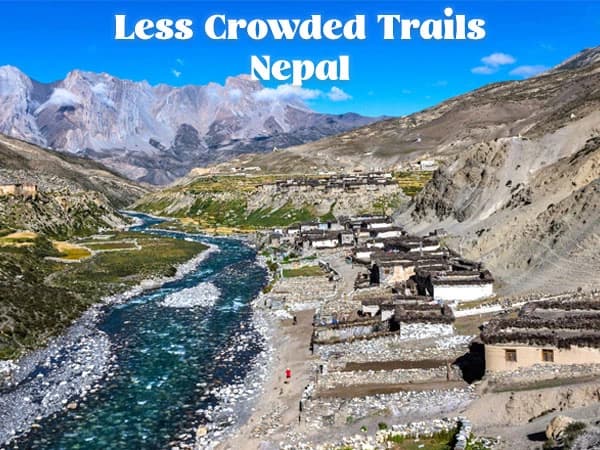Are you thinking of hiking to Everest Base Camp? Find the best time for your trip by learning how each season affects it, from the weather and vistas to the crowds and comfort.
Everest Base Camp Trekking Seasons Explained: Find Your Perfect Time to Trek
The Different Seasons for Trekking to Everest Base Camp
An emotional trip through time, weather, and awe
Have you ever wanted to stand at the base of Everest and be out of breath not just from the height but also from how emotional it all was? The Everest Base Camp (EBC) Trek isn't just a hike; it's a memory that will last a lifetime in the Himalayas. The skies are clear, the weather is stable, and the views of the mountains are at their best.
Spring (March to May) is also great since the weather is pleasant and the rhododendrons are in flower. Winter and the monsoon season aren't as popular since it's quite cold or it rains a lot, but they are good for experienced trekkers who want to be alone.
Are you ready to pick your season?
Your perfect Everest Base Camp journey starts with the right timing, whether you want to see golden autumn sunsets over Ama Dablam or dream of spring trails full of rhododendrons. Shikhar Adventure will help you make it a memory that will last.
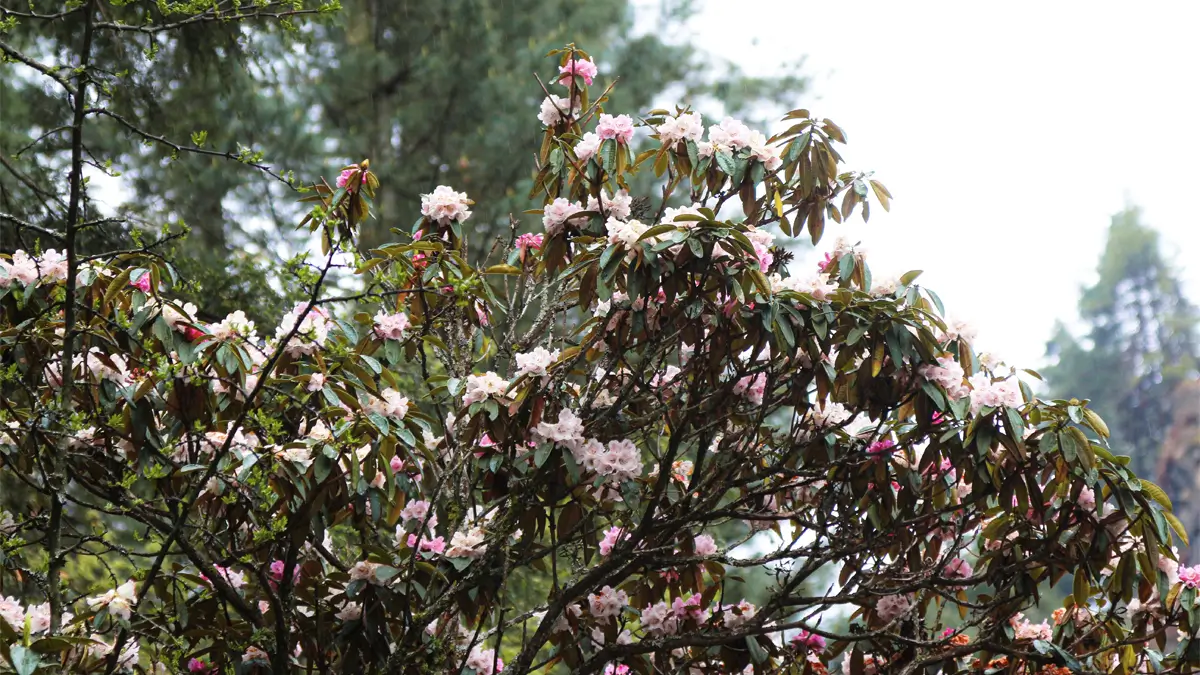
Spring – Nature’s Festival in the Khumbu
Spring in the Everest region isn’t just a season, it’s a ceremony. A welcoming.
Rhododendrons bloom like fireworks along the trail from Phakding to Tengboche, painting the hills in pinks and reds. The air smells of damp ground and pine. Yak bells echo softly as life returns to the highlands after winter's retreat.
- Temperatures: 10°C to -10°C
- Visibility: Clear mornings, occasional hazy afternoons
- Trail Mood: Alive, festive, rejuvenated
You’ll walk through forests where snow melts in tiny trickles, and every bend opens to postcard views of Ama Dablam and Lhotse. By the time you arrive in Namche (the sherpa town), you'll feel reborn.
It was April. Somewhere before Debuche, we passed under a flowering rhododendron tree while Everest peeked between the clouds. I forgot I was hiking for a second. I was floating.
Spring is for you if:
- You crave color and nature in full celebration
- You’re trekking for the first time and want stable weather
- You love sharing energy with other happy trekkers on the trail
Emotional Energy of Spring: Hope. Renewal. Joy.
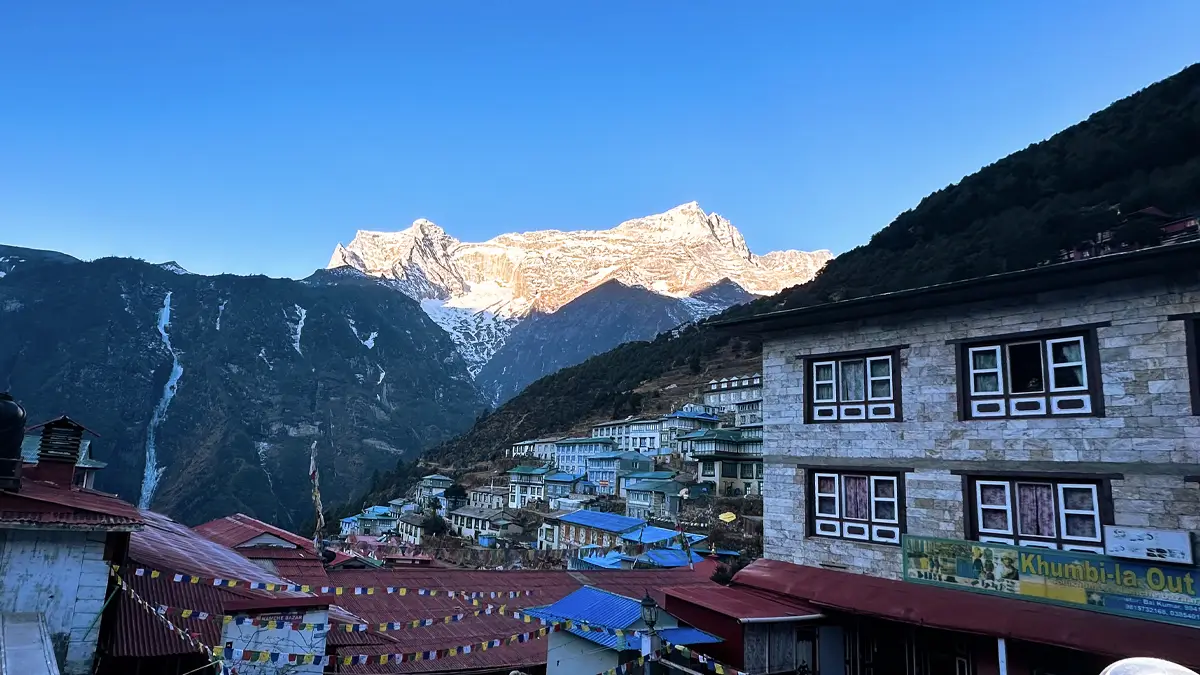
Autumn – The Photographer’s Season (Late Sept to Nov)
The clouds of monsoon have vanished. The air is dry, crisp, and sharp. The sky is so blue it almost hurts to look at it, and the mountains seem close enough to touch.
It makes sense that this is the busiest time for hiking in Nepal. Every step offers a perfectly framed photo. Mornings are still and breathtaking. From the ridge above Namche, Everest glows like a crown at dawn.
- Temperatures: 15°C to -10°C
- Visibility: Unmatched clarity
- Trail Mood: Energized, social, inspiring
But it’s more than just the views. It’s the clarity inside you, too.
One morning at Kala Patthar, the world fell silent. It was -4°C. My breath fogged up my sunglasses. I looked out at Everest and felt this sense of... wholeness. Like the mountain had answered a question I didn’t know I had.
Autumn is for you if:
- You’re a photographer or visual seeker
- You want perfect weather and sunlit views every day
- You’re okay with more people on the trail—it’s festive, not crowded
Emotional Energy of Autumn: Clarity. Gratitude. Awe.
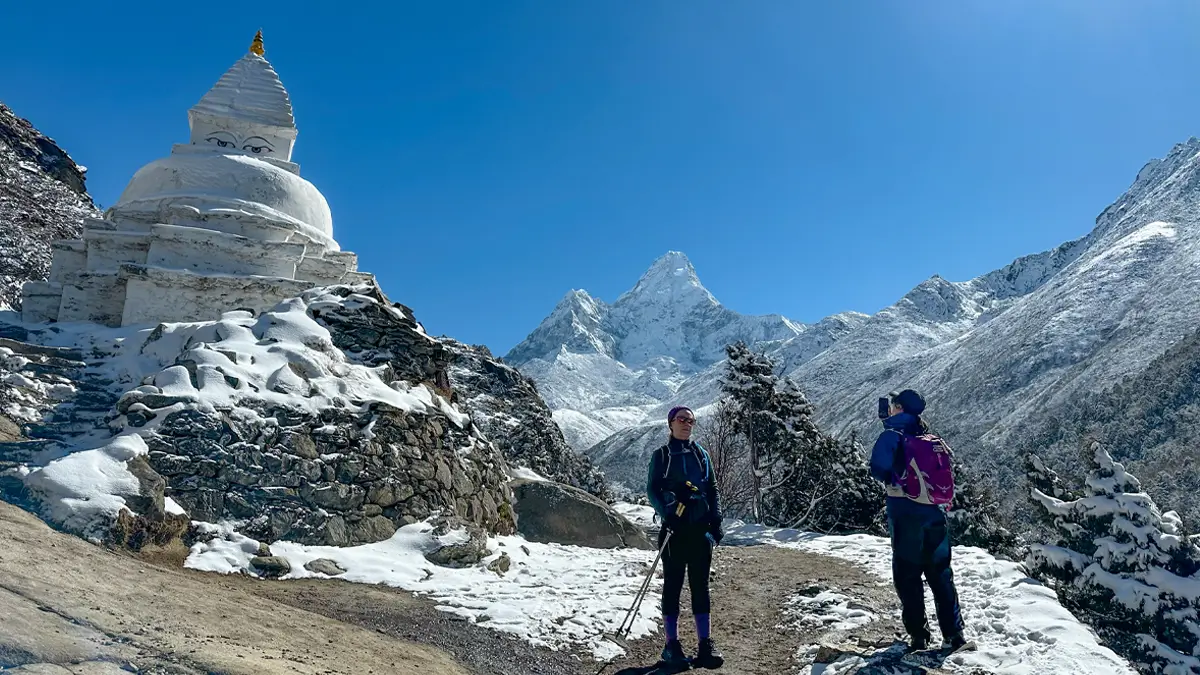
Winter – Solitude, Silence, and the Soul (Dec to Feb)
The trail is empty. The air is glass. The silence is sacred.
Trekking to Everest Base Camp in winter is not for everyone, but for those who do, it’s a pilgrimage. Snow lines the roofs of stone teahouses. Prayer flags freeze in mid-wave. The crunch of your boots is the loudest sound on the trail.
- Temperatures: 5°C to -20°C
- Visibility: Crisp and clean
- Trail Mood: Quiet, meditative, raw
Lodges are open but cozy. The fires are warmer. The conversations slower, more meaningful. You may find yourself sipping tea beside a Sherpa grandmother, her stories as ancient as the mountains outside.
In the fresh snow, I walked by myself from Dingboche to Lobuche. No footsteps ahead of me. No one is behind. It's just me, the wind, and Everest watching.
Winter is for you if:
- You want to be alone and think.
- You've hiked before and want a real adventure.
- You don't mind the cold; you just want to be alone on the mountain.
Winter's emotional energy: quiet, strength, and reflection.
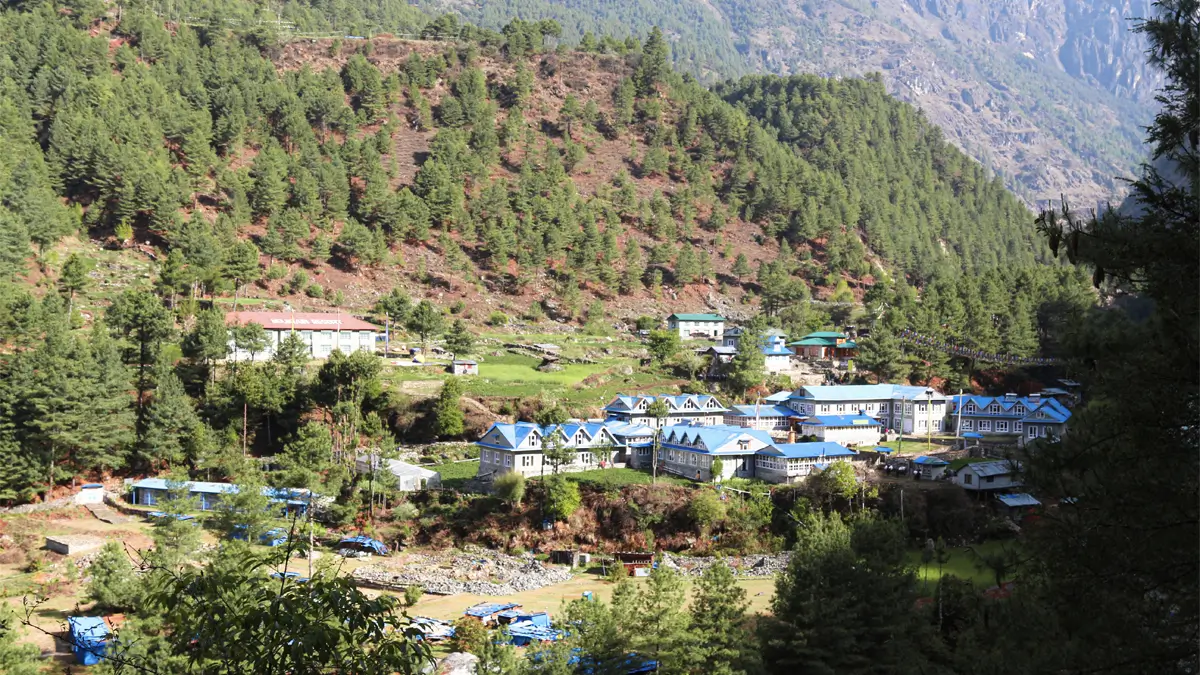
Monsoon – Into the Green Heart of the Khumbu
Monsoon treks are often misunderstood. Yes, there’s rain. Yes, the skies sometimes hide the mountains. But in those moments, the Everest trail feels otherworldly, lush, green, dripping with life. The rivers roar louder, waterfalls appear where cliffs stood bare, and the clouds wrap the trail in mystery.
- Temperatures: 18°C to 0°C
- Visibility: Cloudy, with occasional dramatic clearings
- Trail Mood: Wild, unpredictable, secretive
You’ll find the path almost empty. The few trekkers you meet become close companions because you’re sharing something rare, Everest, without the world watching.
Early one July morning in Namche, it was pouring rain. I thought the day was lost. But by afternoon, the clouds broke. Everest appeared, sudden, massive, glowing against a storm sky. It felt like the mountain revealed herself only to us.
Monsoon is for you if:
- You value quiet more than constant views
- You love nature’s wild moods, mist, rain, thunder
- You’re adventurous and don’t mind wet boots or leeches
Emotional Energy of Monsoon: Mystery. Courage. Discovery.
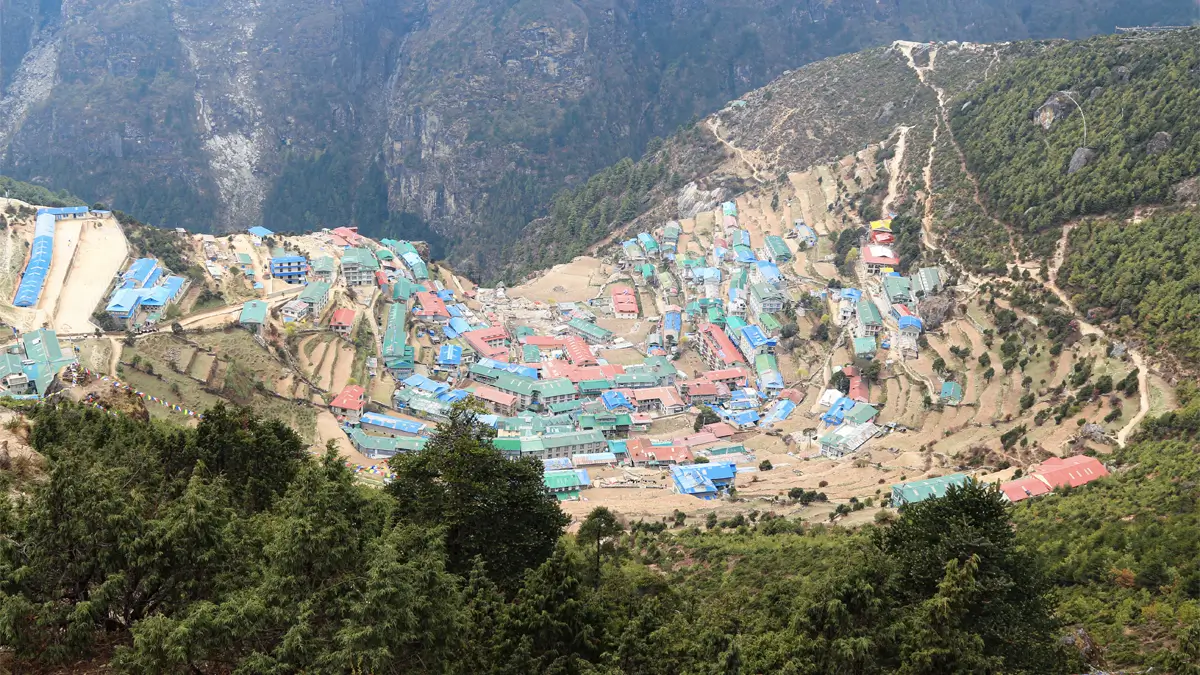
Visual Vibes: The Trail Looks Different in Every Season
Shut your eyes. Picture yourself walking through these times:
- In the spring, a tunnel of blooming rhododendrons with petals falling on your shoulders like confetti. Bright skies make the prayer flags flutter. You can see Mount Everest in the morning fog.
- Autumn: Clear skies and golden light. You can almost touch the peaks. All of the pictures look like they would be great for a magazine cover.
- Winter: The trails are covered in snow and the waterfalls are frozen. The sky is clear and sharp, and the air is clean and thin. Your breath even feels like a part of the mountain.
- Mist hangs around pine trees in the monsoon. Raindrops make waves in turquoise rivers. Then, all of a sudden, the clouds clear, and Everest appears like a dream.
The Himalayas look different in each season. Which one catches your eye?
Who Are You on the Path? Make Your Spirit Fit the Season
Not everyone treks Everest for the same reason. The season you choose should match your travel style.
-
The Soul-Seeker → Winter
You want to be by yourself, quiet, and think. The cold doesn't bother you; it makes your experience deeper.
-
The Nature-Lover → Spring
You love how the earth smells after the snow melts, how the forests look when they're in bloom, and how a trail full of other dreamers makes you feel.
-
The Photo-Chaser → Fall
You want postcard-like skies, sharp ridges, and the perfect sunrise picture at Kala Patthar. You have the gift of clarity.
-
The Quiet Explorer → Monsoon
You don't mind being soaked in mystery. You think mist is beautiful, as are quiet trails and the way Everest only shows herself when she wants to.
So, which one are you?
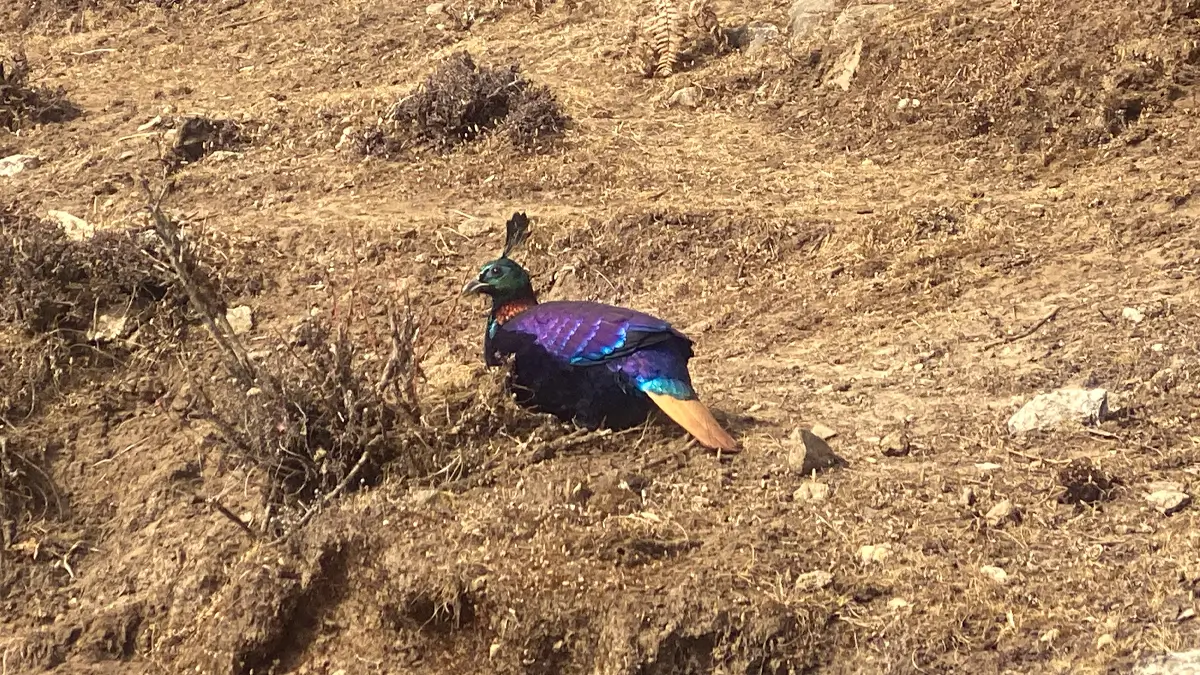
What You Can Expect to Walk Through on the Trail by Season
The state of the trail itself is one of the most important but often forgotten things to think about when planning your EBC trek. The weather has a big impact on how safe, fun, or hard your walks will be each day.
- In the spring (March to May), the trails are dry and hard, however they can be muddy in early March. Snow may stay around longer at higher elevations, but it's usually packed down and easy to deal with.
- Autumn (September to November): The best weather for hiking is crisp, dry paths with good footing. In some dry locations, there is loose gravel.
- In the winter (December to February), there will be snow and ice in shady or high areas, especially near Base Camp and passes. You need micro spikes or crampons.
- The monsoon rains transform the trails into a muddy challenge, and occasional landslides can impact the Lukla–Namche section.
Emotional insight:
Knowing what's under your feet makes you feel safe. Every step you take, whether it's on dry stone steps or through fresh snow, puts you closer to your dream: Everest.
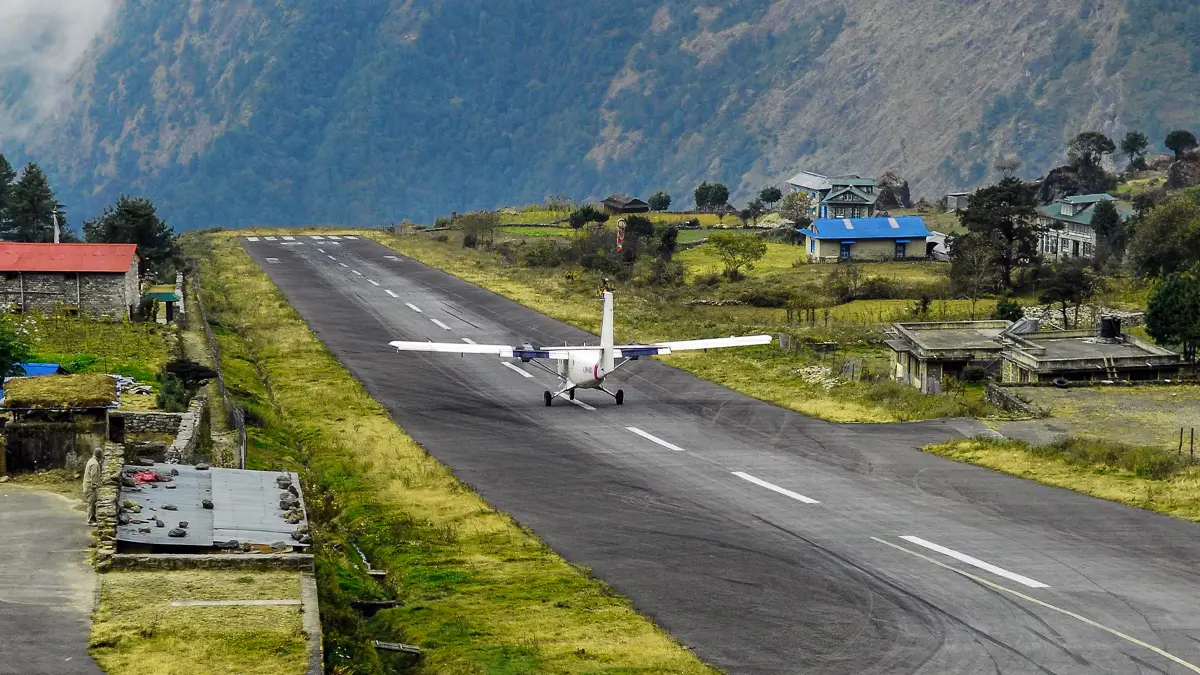
Weather Impact on Flights to Lukla
Lukla Airport is notable for being dramatic because it is between cliffs and depends on the weather. The time of year you choose to trek will impact how smooth (or unexpected) this phase of your trip will be.
- Spring and fall are the greatest times to fly safely and on time. When the sky is clear, planes can take off and land at the same time.
- In the winter, you can fly early in the morning, but fog or frost often causes delays.
- Monsoon: Lots of cancellations. If you can afford it, consider a helicopter transfer or be ready to change your plans.
If your dates are set and you can't afford to be late, you could want to fly to Phaplu and hike for two more days, or you could budget for a helicopter ride from Kathmandu.
Emotional understanding:
Lukla airstrip isn't just a runway; it's the beginning of your trip. Many trekkers feel the reality of Everest settle in when they hear the engines scream and take off into the Himalayas.
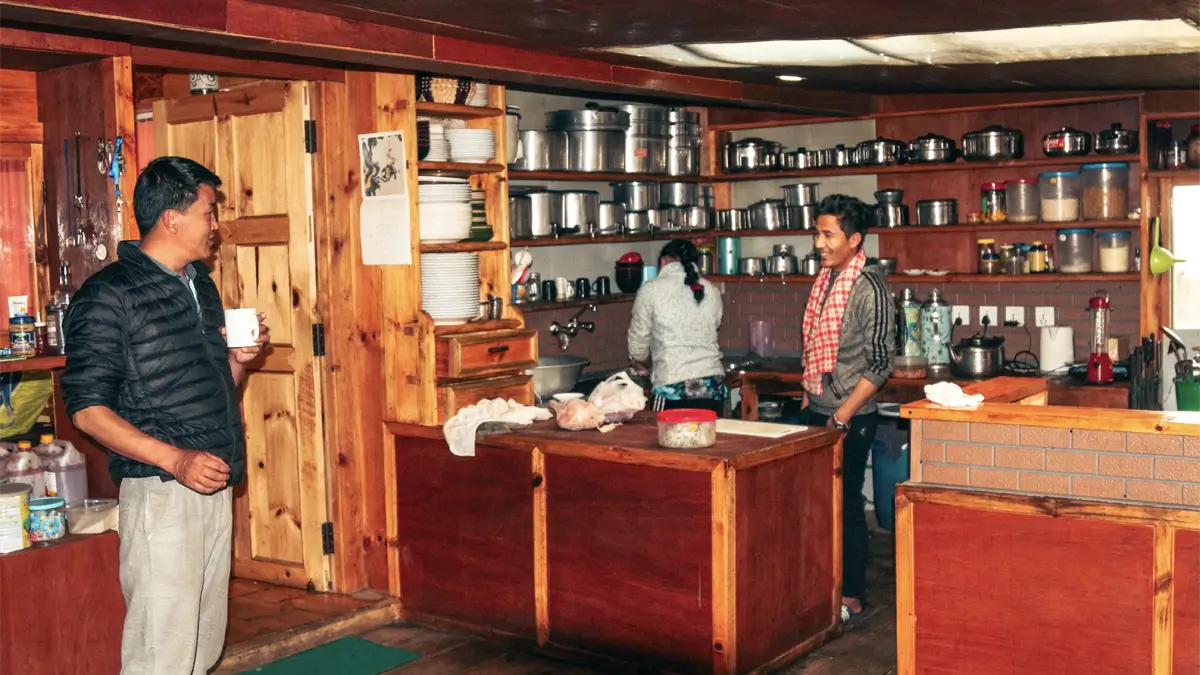
Comfort and Availability in the Teahouse
Your nighttime breaks are more than simply somewhere to sleep; they're where you meet new people, tell stories, and let your muscles relax after climbing for a long time. Seasonal changes, though, affect both the quality of teahouses and their supply.
- All the teahouses are open and busy throughout the spring and fall. At each destination, you'll have choices, but popular places fill up quickly, so book early.
- Winter: A lot of teahouses above Tengboche close. You can expect simple services, rooms that are shared, and not a lot of hot water.
- Monsoon: Teahouses at lower elevations are open, but some at higher elevations may close for a short time because there aren't enough trekkers or because of damage from excessive rain.
Emotional insight:
There's nothing like drinking ginger tea over a yak-dung stove while snowflakes dance outside your window. Or sitting inside a wooden lodge and listening the thunder roll through the valley. These calm times will be the ones you miss the most.
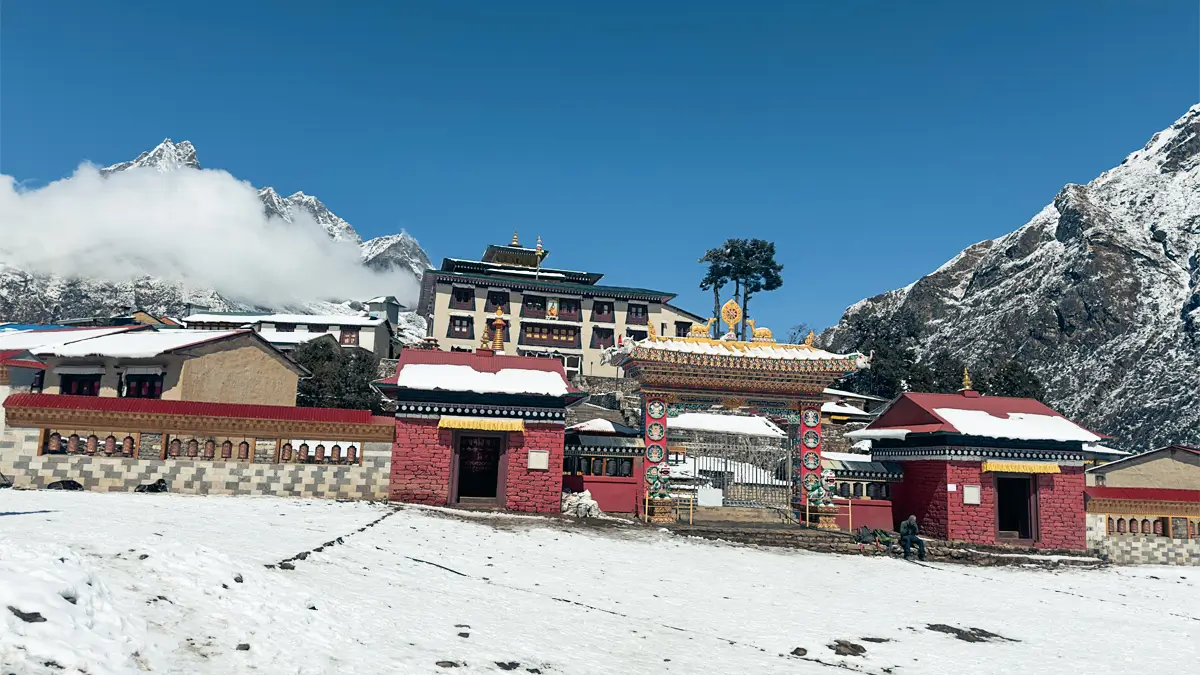
Seasons of Festivals, Wildlife, and Local Life
Trekking isn't just about the mountains; it's also about the people, animals, and lively culture you meet along the way. Picking the right season enables you plan your trip around these interesting events.
- In the spring, rhododendron woods bloom and Himalayan monals, Nepal's national bird, are active. People are busy in the villages getting their fields ready and the paths fixed.
- In the fall, you may see Dashain and Tihar, Nepal's two greatest celebrations. There are celebrations and blessings all over the trails and in the communities.
- Winter: There is less activity in the area, and some families move to lower areas. But animals like snow leopards and blue sheep are more active at lower altitudes, even though they are hard to find.
- During the monsoon, there are many of plants, insects, and butterflies. Farming is at its busiest, and you'll see how life is in the country.
Insight:
Every person you meet and every story hears thefts on bodies of water adds to your own. These cultural and natural events link you to something that has been around for a long time: a mountain community that has lived in peace with these peaks for centuries.

What to Bring for Each Trekking Season
Packing for Everest is a skill that requires finding the right balance between bringing too much and too little. You need to choose the right gear for each season to be comfortable, safe, and successful.
Spring and fall (high season must-haves):
- System of layered clothes: A base layer, fleece, down jacket, and waterproof shell.
- Good trekking boots: Already broken-in, waterproof.
- UV protection: Sunglasses, sunscreen, lip balm.
- Sleeping bag: At least -10°C rated (teahouses provide blankets, but temps drop fast).
- Other musts: Water purification tablets, energy snacks, lightweight micro spikes (for spring snow patches).
Winter:
- Heavy down jacket + windproof outer shell
- Glove liners + insulated mittens
- Thermal base layers + wool socks
- Crampons or micro spikes for icy sections
- Headlamp with extra batteries (days are shorter)
Monsoon:
- Full rain gear (jacket + pants)
- Quick-dry clothes
- Waterproof backpack cover
- Leech socks for lowland walks
- Fungicide cream and extra plastic bags (to keep wet clothes separate)
Emotional insight:
What you carry isn't simply gear; it's your shield, your comfort zone, and the result of all your hard work. When everyone else is cold, wet, and shivering, and you're warm, dry, and smiling, you'll be glad you packed everything smart.
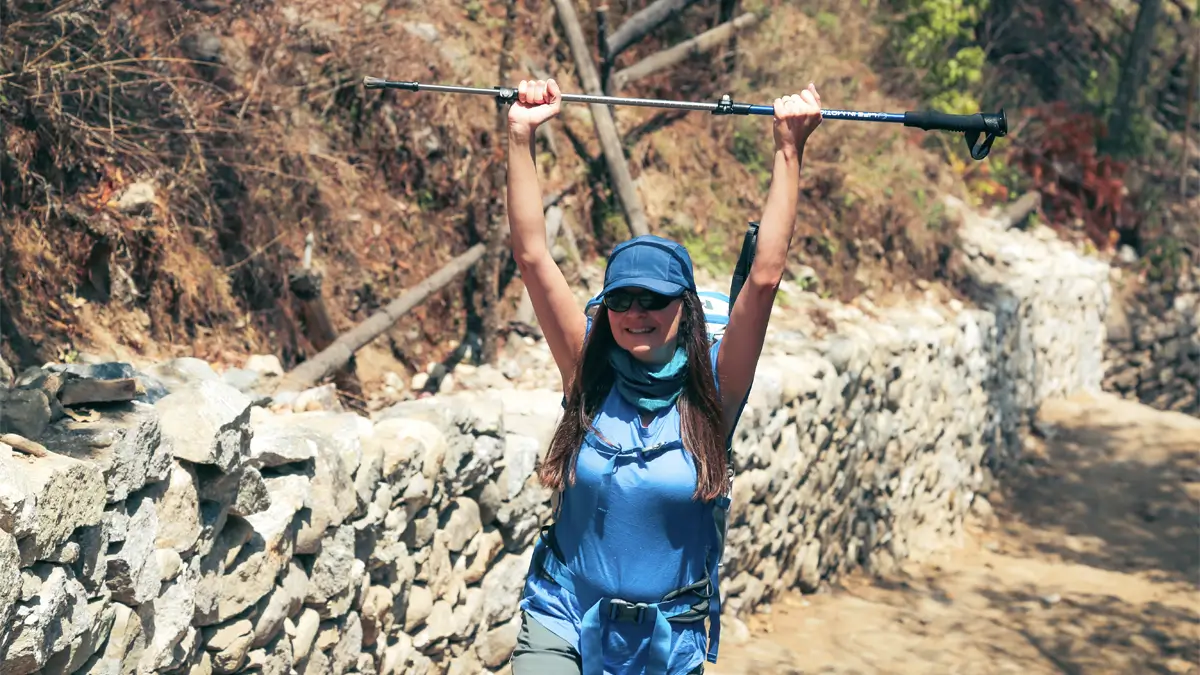
Seasonal Tips for Acclimatization and Altitude
The most difficult part of the Everest journey is the altitude, no matter what time of year it is. But depending on the season, your body may react differently and the voyage may be more or less flexible.
Spring and fall:
- Clear weather lets you choose the right pace and take breaks.
- Most plans include two stops to help you get used to the altitude. These are usually Namche and Dingboche.
- A stable environment helps your body react in a predictable way.
Winter:
- If the air is dry, you may lose water more quickly.
- In high places, it can be hard to sleep on cold nights.
- To acclimatize safely, you need to layer your clothes and drink enough water.
Monsoon:
- As you go up in elevation, the humidity makes you sweat more.
- Wearing wet clothes or gear can make you more likely to have respiratory infections.
- Put warm clothing in dry bags and make sure you drink enough water and eat enough food to keep your heart and lungs healthy.
No matter what time of year it is, follow the advice to "climb high, sleep low," drink 3 to 4 liters of water every day, and stay away from alcohol. Everest isn't a race; it's a journey of respect and being in sync with your body.
Emotional insight:
Altitude doesn't care how fit you are; it makes everyone feel small. Pay attention to your breathing. Take a break when your body tells you to. When you wake up at 4,000 meters with no headache, celebrate because you're becoming one with the mountains.
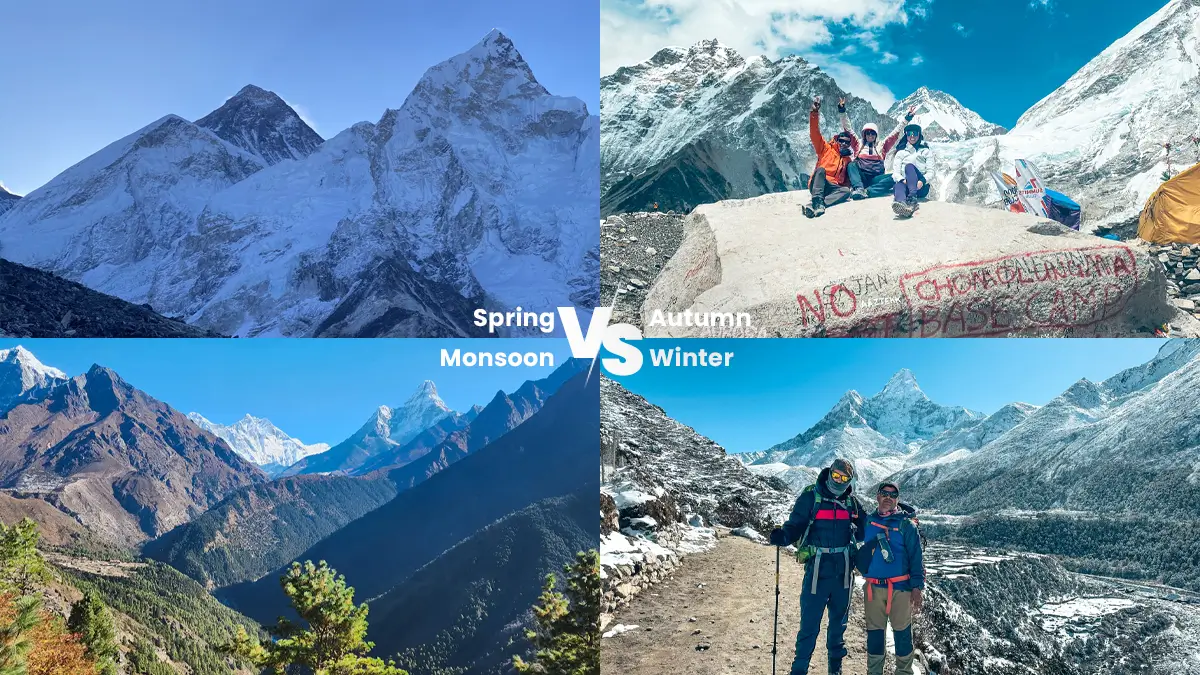
Everest Compared to Other Treks by Season
Everest Base Camp is famous, but it's good to know how it compares to other hikes in different seasons, especially if you want something different, peace and quiet, or other views.
| Trek | Best Season | Why Choose It? |
|---|---|---|
| Everest Base Camp | Spring & Autumn | World-famous views, Sherpa culture, iconic landmarks |
| Gokyo Lakes & Renjo La | Spring & Autumn | Fewer crowds, high passes, turquoise glacial lakes |
| Annapurna Base Camp | Spring & Autumn | Less altitude stress, lush scenery, rich culture |
| Mardi Himal | Winter & Spring | Shorter, offbeat, great for first-time trekkers |
| Upper Mustang | Monsoon (June–Aug) | Rain-shadow zone—dry even during summer |
| Manaslu Circuit | Autumn | Wild, remote, circuit-style, Tibetan influence |
Emotional insight:
The best part of the Himalayas is Everest, yet every road has its own beauty. Picking the perfect route for the correct time of year doesn't make your trip easier; it makes it yours.

Customizing Your Everest Itinerary by Season
The rhythm of your days on the trail should reflect the season you choose. While most itineraries follow the same route, adjusting pace and stops according to weather and trail conditions can make your trek safer and more enjoyable.
- In the spring and fall, 12 to 14 day itineraries work great. During your days of getting used to the altitude, visit the beautiful valleys in the spring or the fun events in the fall. Get up early to see the clear morning views.
- Winter: To fight the cold and high altitude, think about adding an extra day or two of relaxation. It can be icy at lower levels, so take your time and be careful. Those long nights are great for reading and staying warm inside.
- Monsoon: The days are shorter and the trails are slippery, so it's best to start early and plan on going slowly. Be ready for rain by bringing waterproof gear and being flexible with your Lukla flight plans. You might want to think about taking different routes or side trips in places where it doesn't rain as much.
Emotional insight: Your travel plans are a pledge to yourself, a deal between your adventurous side and your body's necessities. There are moments that will last a lifetime on Everest if you treat it with respect.
What to Expect When You Budget Your Trek by Season
The season you choose can also have a big impact on your finances.
- Spring and Fall: Prices for flights, lodgings, and guides go up during peak season. If you want to get the best deals and rooms, you should book early. Lodges that are full could charge extra for hot showers and food.
- In the winter, there are fewer trekkers, which means reduced costs, but some lodges close or only offer limited services. If flights are canceled, you may have to pay more for warm clothes and helicopter rides.
- Monsoon: The time of year when things are usually the cheapest. There are lots of deals on tours and hotels, but you should keep in mind that you might have to pay extra if you have to wait, buy rain gear, or change how you get to your destination.
Emotional insight: You're not just spending money; you're also spending time that you'll remember. Every rupee you spend puts you closer to the wonder of Everest, whether you spend it on comfort or adventure.

Local guides & Sherpas' Insider Tips
Who better to help you understand Everest's moods than the individuals who have lived its stories for generations?
- Always listen to the weather advice in your area. Sherpas know when to move and when to relax. They can read the mountains like a book.
- Drink plenty of water and eat dishes from the area. Fresh fruits and vegetables in season provide you more energy than food from other countries.
- Keep your spirits high and your stuff dry. A good attitude is the best raincoat, especially during the downpour.
- Be patient in Lukla. The mountain decides when flights come and depart, not you.
- Bring modest presents for the villagers. A kind act opens hearts and stories.
Emotional insight:
Guides aren't simply good at planning; they're also your link to the soul of Everest. Have faith in what they know, be honest about your trip, and you'll come home with more than just pictures.
Frequently Asked Questions: The Emotional and Practical Questions
I desire quiet. When should I leave?
If you choose winter, you'll enjoy calm routes, silent evenings, and nearly the whole mountain to yourself.
I don't want to miss the views on my way to Everest. What time of year is the safest?
Autumn has the clearest skies and the best weather for seeing the mountains every day.
Will I see flowers on my route to Everest?
Yes, spring is the time when rhododendrons bloom, making the woods look like a painter's dream.
What if I hike during the monsoon? Will I see Everest?
Yes, but not all the time. The views are rare and breathtaking, and they often show up out of nowhere after the clouds clear.
I'm just starting out. What time of year is optimal for my trek to Everest Base Camp?
In the spring or fall. The weather is good, the trails are crowded yet helpful, and the lodges are ready.
I prefer solitude. Is it still possible for me to enjoy EBC?
Definitely! Go in the winter for peace and quiet, or in the monsoon for empty trails and real adventure.

In summary, the mountain meets you where you are
Everest Base Camp is not just a place to go trekking; it's a mirror. The mountain shows your hopes, your bravery, and your preparation. The mountain meets you where you are, whether you stroll through spring flowers, autumn's golden light, winter's quiet snow, or the monsoon's emerald embrace.
Each season has its own type of enchantment. Every time you travel, your journey will be different because you are different.
So, when are you going to heed the mountain's call?
Your trip to Everest is waiting for you. Let our professional staff assist you choose the best season and get you securely to Base Camp.


